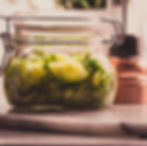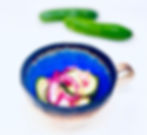How to make fermented foods part of your life without much fuss.
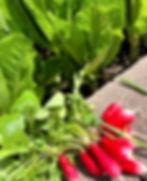
SHORT AND LONG-TERM SEASONAL PICKLING
Mary McCabe marysveggiecooking.com
SAUERKRAUT

Ingredients
The standard proportion for cabbage to salt:
5 lbs. cabbage and other crisp vegetables to 3 Tbsp. sea salt or Himalayan salt
Brine - 1 qt water to 1 ½ Tbsp. Sea salt
Math can be confusing since most of us don’t make 5 lbs. at a time.
I made 2 ½ lbs. Cabbage to keep it simple, with 1 ½ Tbsp. sea salt
It is essential to use a digital scale to weigh the vegetables to know the correct amount of salt.
A salinity ratio of 1.5% to 2.5% ensures a safe and delicious fermentation.
Method
1. Shred the cabbage thinly and evenly. Put in a non-metal, food-grade container.
Add the sea salt and mix lightly with clean hands. Set aside for 20 to 30 minutes.
2. Begin to “massage” cabbage and sea salt with clean, well-rinsed hands, with no soap
residue. Continue to rub the cabbage mixture until a good amount of liquid is released,
about 10 minutes.
3. Place a portion of cabbage in a sterilized jar or crock. Use a tool
such as a kraut pounder, wooden spoon, or smasher to push down the cabbage, so
the brine is ½ inch above the kraut. Repeat in batches, pressing down
until all the kraut is in the container, leaving 2 inches of head space open to the top.
4. Press so the brine is above the kraut. Use a fermentation weight or food-grade plastic
a bag full of brine to set on top of the kraut.
5. Use cheesecloth or clean cotton to cover and a fermenting lid. Do not close the lid tightly.
It needs to allow any gas to be released. Place the kraut container on a shallow dish
to catch any brine overflow.
6. Leave the new kraut in an area for 5 to 8 days, not in direct sunlight, depending on
The temperature. The ideal temperature is 68 to 75 degrees. Check every day, and look for
bubbles. Once the liquid has a chance to settle and the bubbles no longer rise to the surface, it indicates that the fermentation has stopped. As a result, the color has gone from white to golden yellow.
7. Smell it. It should smell and taste like sauerkraut. You can store the kraut in the refrigerator, tightly covered for 2 to 3 months, ensuring the brine covers the kraut.
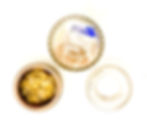
Sauerkraut Dish, Pickle Jar with Glass Weight, Brine Filled Bag & Lid

Sauerkraut Shown in Jar, as a side,
Glass & Brine Filled Bag Weight
*Mary's Notes
Amazon offers various fermentation products, such as Mason jars and Ball lids.
Sauerkraut needs an anaerobic (without oxygen) environment to ferment successfully.
To achieve this, you must ensure no air gets into the kraut mixture by using the weights or brine bag to keep the air out. Also, keep the kraut submerged under the brine to prevent spoilage.
Lay the outer cabbage leaves on top to keep any floaters from jumping to the top.
________________________________________________________________________
Ingredients
One large, heavy napa cabbage washed and well drained
3 or 4 scallions cut into two” lengths
One small carrot cut into two” slivers
¼ onion in half moons
6- 8 cloves of garlic minced
Thumb size piece of peeled ginger, julienne
1 Asian or Bosc pear slice thin strips
2 to 3-inch daikon radish, julienne
3 to 4 Nira cut into two” lengths
⅓ to ½ cup sea salt, kosher, or pure salt
Gochugaru - Korean red pepper flakes or powder
Cut Vegetables befoer Mixing with Starch to go inside the Napa
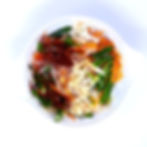
Starch gravy
¼ cup sweet rice flour
One cup of dashi stock (1 ½ cup water to two” piece kombu slow boil to one cup)
Method
Cut napa cabbage in half and quarters. Carefully spread loose cabbage leaves, and sprinkle salt between each layer. Place in a bowl, covered, cut side down for
Four hours up to overnight.
You can tell the cabbage is ready by bending and rolling the thick part back and forth.
Rinse between each leaf at least three times in a bowl and then under running water. Be gentle.
Drain the rinsed cabbage in a strainer for 30 minutes.
Tasting is the best way to see if the cabbage is salted correctly.
Mix all the sliced veggies for the stuffing with two teaspoons of salt and the starch mixture to create the kimchi paste.
Add red pepper spice to your taste. Optional.
Add part of the paste to the inside of the thickest part of the napa cabbage. Repeat until the mixture is on each layer of the leaves. Finally, coat the outside of the cabbage with paste, and wrap the last two leaves around the bundle to secure.
Preferably place in a large container to fit all the kimchi. Cover with plastic wrap to keep the juices in. Keep on a counter away from heat or sun for 10-12 hours, then refrigerate.
You can begin eating kimchi after five days. It will keep for 3 to 6 months in the refrigerator.
Take out what you eat in a week and leave the rest untouched during storage.
Amazuke - Tsukemono Sweet Pickles
Ama means sweet, and zuke means pickling.
Ingredients #1
One cup Rice vinegar
½ cup Maple syrup
2 tsp. Sea salt
Method #1
Bring all ingredients to a boil over medium heat. Once boiled, turn the heat off. Allow it to cool.
Ingredients #2
Carrot two inches sliced into thin strips
Daikon two inches cut in ¼ inch sticks
½ tsp. Sea salt
Mix the daikon and carrot with the salt in a sealed bag or bowl. Set aside for 15 minutes.
Pour off excess liquid from the salted veggies. Add cooled vinegar mixture, place in a jar and allow to marinate. Good to eat in two weeks. Serve in a bowl with brine. Squeeze lemon juice for taste. I like to add green shiso feathers and chili threads for a spicy color.
Red Radish Pickles
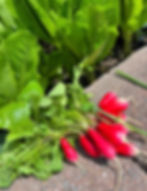
Garden Organic Radishes
Ingredients
Small bunch of red radish 8 oz.
½ tsp sea salt
Two Tbsp. Ume vinegar
Method
Slice the radish into thin slivers and mix well with salt in a bowl. Place a lid with a weight on top. Below shows a salad press, which makes it easier to press.
Allow the excess juice to be released and strain off excess.
Place in a glass jar, mix in Ume juice and marinate with a lid and a weight overnight.
Keep it in the refrigerator. It will be pink and suitable for weeks.
You can add ginger juice, sesame seeds, etc., when serving.
Pickled Ginger
Ingredients
3 oz. Peeled ginger sliced thin with peeler
½ tsp. Sea salt
1/4 cup rice vinegar
1/4 cup maple syrup
1 tsp. Ume juice
Method
Mix sliced ginger with sea salt well in a bowl and press a weighted lid to pull out excess liquid for 30 minutes.
Squeeze it out with your hands. Discard excess liquid. Mix in a jar with the rest of the ingredients. Cover with a cloth and leave overnight. Keep the brine over the ginger in storage.
Asazuke Salad
Ingredients
For Brine - 1 ½ tsp. Sea salt two cups good water One two-inch piece Kombu
½ lb. cabbage cut into 1-inch chunks
½ lb. carrot cut in matchsticks
½ tsp. Sea salt
Method
Bring the brine to 140 degrees, turn it off, and allow it to cool
Mix ½ tsp. Add salt, cabbage, and carrots, and sit for 30 - 40 minutes.
Squeeze off excess salt. Pour the cooled brine over the cabbage and carrot mixture into a jar and marinate for 2 to 6 hours. Refrigerate, ready to serve.
Cucumber Salad
